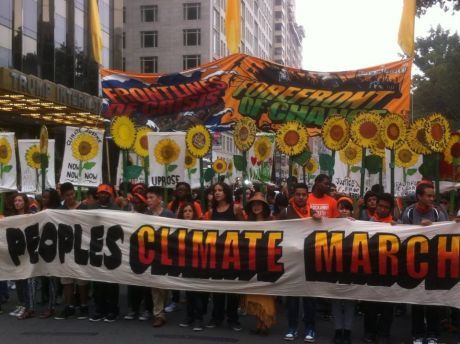Reports
You are here
People's Climate March: a movement rises

September 22, 2014
September 21 was the largest climate justice event in history, with 2,600 events organized in 150 countries, including a massive march in New York. Organizers had hoped for 100,000 people, which would have doubled the march outside the White House last year (previously the largest climate march in US history). Instead, up to 400,000 people marched on the UN climate change summit to demand action on climate change.
It was a sea of humanity, rising from across the country and around the world. Stretching thirty of New York's long city blocks blocks along Central Park (where horse-drawn carriages had placards reading "another Teamster for green jobs), the front of the march started moving before noon and by 3pm the back of the march had not yet begun. The mood was festive but also serious. Before 1pm there was a minute of silence, as the hundreds of thousands of people stood with their hands in the air, and then a tidal wave of noise to sound the alarm on the climate crisis.
The motto of the march was "to change everything we need everyone," and the march united all those affected by climate change and fighting back. The march was led by youth at the centre of climate change and resistance, under the banner "Frontlines of Crisis, Forefront of Change." This was followed by an indigenous contingent from across Turtle Island, with the banner "Respect Indigenous Peoples' Rights: End CO2lonialism." There were contingents of students fighting for their futures, and elders defending the next generation. There were contingents of migrant workers fighting for their rights, and dozens of labour organizations demanding green jobs alternatives. There were demands for wind and solar, and opposition to nuclear, coal, fracking and artic drilling; as one placard said, "what happens in the arctic doesn't stay in the arctic." There was a peace and justice contingent--including a Palestine solidarity contingent, a "stop the wars, stop the warming banner" and a massive ballon by Veterans for Peace explaining the US military is the largest conumer of oil and largest emitter of carbon dioxide. There were scientist and healthcare organiztions, faith organizations and community groups demanding a right to housing.
There were many from outside the US, including from Brazil, Peru, India and Senegal. Hundreds of people from Canada attended--including one carrying a sign reading "Canada is angry: where is Harper" (Harper boycotted the UN summit)--and there was an anti-tar sands contingent to challenge tar sands and pipelines and demand divestment.
The march also reflected debates in the movement, with some calling simply for dietary, tax or electoral changes as a climate fix. But in the days before the march 2,500 people attended a climate convergence conference to discuss system change. At the closing plenary Naomi Klein spoke about her new book, concluding that "the real climate leaders and in the streets," and that "There are no non-radical options left on the table. Climate change will either change everythign about our physical world, or to stop it we will have to change everything about economic and political world." Today there is a "flood Wall Street" event of direction action in the financial district.
The UN climate summit--a gathering of states representing polluting industries and armed with polluting militaries--will be incable of meeting the needs of the planet and its people. But the urgency, enthusiasm and confidence of the historic march and the 2,600 other actions that day will send ripples around the world, building a rising movement that will need to achieve system change if we are to stop climate change.
Section:
Topics:










